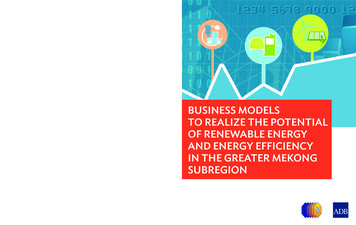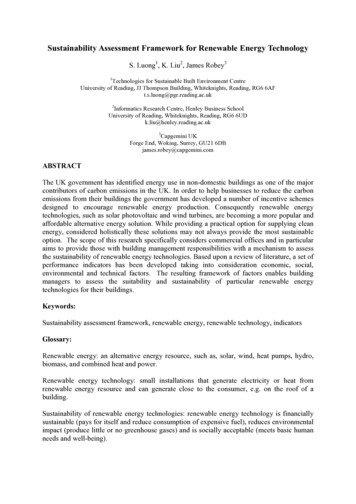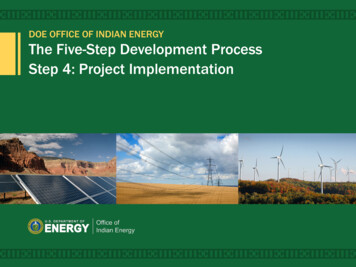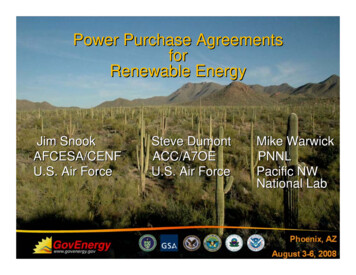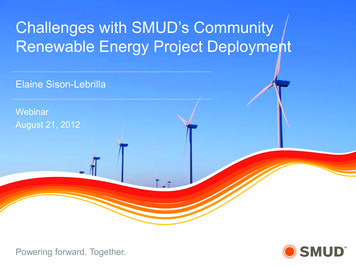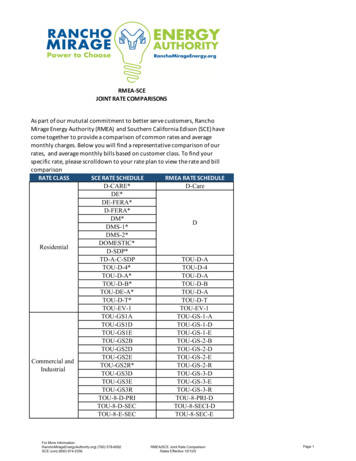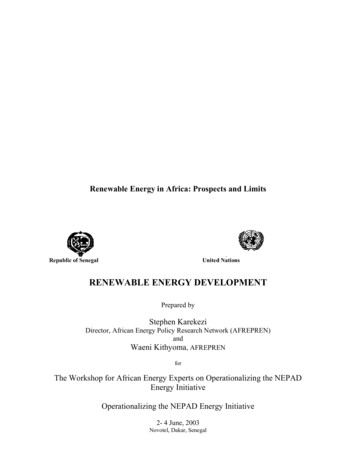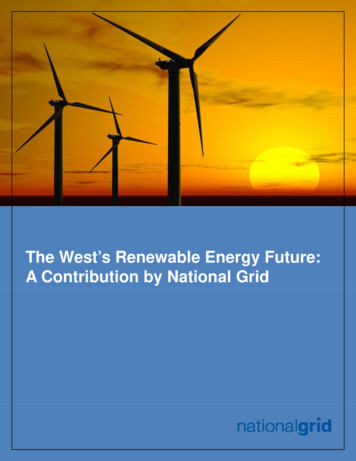
Transcription
The West’s Renewable Energy Future:A Contribution by National Grid
The West’s Renewable Energy FutureA Contribution by National GridJuly 2008THE WEST’S RENEWABLE ENERGY FUTUREA CONTRIBUTION BY NATIONAL GRIDTABLE OF CONTENTSList of Acronyms . 21Executive Summary . 32Introduction. 53Regional Environmental Goals and Needs . 63.1Western US Population Growth . 63.2Electricity Sales Growth and Energy Efficiency. 73.3Western States RPS Based Renewable Energy Demand . 83.42020 GHG Emission Reduction Targets . 103.5Range of Renewable Energy Needs . 123.6Potential GHG Emission Costs . 133.7Section Summary and Conclusions . 154Potential Renewable Resource Solutions . 164.1DSW Region Renewable Resource Availability . 164.2Wyoming Wind Resource Potential . 194.3Section Summary and Conclusions . 245Transmission Solutions . 255.1Background . 255.2Transmission Solutions and Costs . 255.3TWE Energy Transmission Costs . 265.4Transmission Grid Operations. 275.5Section Summary and Conclusions . 286Economic and Other Objectives . 296.1Summary of Resource Costs . 296.2Backing Up Intermittent Energy Sources . 316.3Land and Water Use Considerations . 316.4Section Summary and Conclusions . 327Summary and Conclusions . 33Appendix A – Major DSW Electric Utilities . 36Appendix B – RETI Phase 1A Technology Cost Summary . 37Appendix C – Representative TWE Map . 38Appendix D – Plant Assumptions . 39Appendix E – Overview of Economic Analysis Results . 40Appendix F – Natural Gas Price Assumptions . 41Appendix G – Natural Gas Price Volatility . 42Appendix H – GHG Cost Sensitivities . 43Bibliography . 44Page 1
The West’s Renewable Energy FutureA Contribution by National GridJuly 2008LIST OF IRMATSRPSTTPTWETWRAWCIWECCWGAWREZAlternating CurrentArizona Public Service CompanyAmerican Wind Energy AssociationBusiness-As-UsualCarbon Capture and StorageClean and Diversified Energy Advisory CommitteeCalifornia Energy CommissionCarbon Dioxide EquivalentCalifornia Public Utilities CommissionConcentrating Solar PowerDemand Side ManagementDesert Southwest (Arizona, Nevada and Southern California)Environmental Protection AgencyGreenhouse GasGigawatt HourHigh Voltage Direct CurrentInvestor Owned UtilityIntegrated Resource PlanInvestment Tax CreditKilovoltLevelized Cost of EnergyMillion Metric Tons of Carbon Dioxide EquivalentMegawattMegawatt HourNational Renewable Energy LaboratoryProduction Tax CreditPhotovoltaicRenewable Energy Transmission InitiativeRocky Mountain Area Transmission StudyRenewable Portfolio StandardTehachapi Transmission ProjectTransWest ExpressTehachapi Wind Resource AreaWestern Climate InitiativeWestern Electricity Coordinating CouncilWestern Governors’ AssociationWestern Renewable Energy ZonesPage 2
The West’s Renewable Energy FutureA Contribution by National Grid1July 2008EXECUTIVE SUMMARYThis Report has been prepared by National Grid and Energy Strategies, LLC. National Gridowns and operates significant electric transmission assets in the Northeast and the UK andis a leading contributor on electric transmission policy issues. i Energy Strategies is anenergy consulting firm based in Salt Lake City, Utah that has supported National Grid’sdevelopment efforts in the West.This Report has been prepared to contribute to the current debate on the West’s renewableenergy future, including the recently initiated Western Governors’ Association (WGA)sponsored Western Renewable Energy Zones (WREZ) project. It builds on NationalRenewable Energy Laboratory (NREL) databases of renewable energy resources andcompliments the work already undertaken by the California state agencies and public utilitieswith Phase 1A of the Renewable Energy Transmission Initiative (RETI) study.Population in the West is growing rapidly which is, in turn, driving an increasing demand forenergy in the region. In addition, many states have implemented Renewable PortfolioStandards (RPSs) requiring a certain percentage of electricity sales to come from renewableresources. This Report concludes that the US portion of the Western Electricity CoordinatingCouncil (WECC) region will require 116,000 GWh per year of new renewable energysources to meet 2020 RPS goals, requiring an investment in excess of 100 billion. TheDesert Southwest (DSW) region (that, for the purpose of this Report, consists of Arizona,Nevada and Southern California) will require approximately 50 percent of this total, or about55,000 GWh by 2020.The analysis in this Report also considers the impact of the Western Climate Initiative (WCI)and possible federal greenhouse gas (GHG) legislation on the electricity sector. While it isstill not entirely clear how the WCI will affect the electricity sector, this Report concludes thatit is credible to assume that the WCI could stimulate even greater demand for newrenewable energy resources than RPSs. Similarly, there is some uncertainty about thedesign and extent of federal GHG legislation, but the prospect of such legislation has alreadysent market signals to Western utilities, many of which have begun to evaluate a costassociated with carbon dioxide emissions in their resource plans. This acts as a furtherstimulus to develop new renewable energy.Between RPS requirements and GHG reduction goals the demand for new renewableenergy is considerable. The RETI report recognized wind and solar as two of the moreviable, large scale renewable technologies. Based on NREL data, the potential of Arizona,California and Nevada’s concentrating solar power (CSP) and wind resources is 2.2 millionGWh per year and 85,000 GWh per year, respectively. The potential of Wyoming’s Class 6and 7 wind energy resources is 235,000 GWh per year and the potential of Wyoming’s Class4 and above wind energy resources is 944,000 GWh per year.These potential energy figures are all highly theoretical and overlook various practical andcost issues. However, they serve to illustrate that these are the two jewels of the region’sresource potential and that they dwarf the potential capacity for all other renewabletechnologies and resources in the region combined. A further illustration of Wyoming’s windpotential is that NREL data shows that over 50 percent of the best quality (Class 6 and 7)wind resources in the continental US are located in Wyoming. This vast Wyoming resourceis, however, remote from large load centers and new long-distance transmission is requiredto move this power to market.National Grid has been the lead developer of the TransWest Express (TWE) transmissionproject. TWE is a proposed 3,000 MW, 3B, 500 kV, HVDC transmission line that will runfrom wind rich southeast Wyoming to a terminal in southern Nevada from where the marketsPage 3
The West’s Renewable Energy FutureA Contribution by National GridJuly 2008in Arizona, Nevada 1 and Southern California can be accessed. The project is due to beoperational by 2014.Because Wyoming wind is remote from the DSW markets this Report considers the costsand issues associated with building new interstate transmission (based on the TWE project)and compares the delivered cost of Wyoming wind against CSP and other generationsolutions for the DSW. This Report concludes that: The best Wyoming wind is the lowest cost renewable energy solution for the DSW,with a delivered cost range of 72 to 101 per MWh (2008 ). Wyoming wind, delivered to the DSW, is significantly less expensive than CSPresources. As a less mature industry the future cost of CSP in the DSW is harder topredict but is forecasted to remain a more expensive solution in the range of 143 to 220 per MWh (2008 ). Under nearly all scenarios evaluated wind is competitive with natural gas firedgeneration as an energy resource.The Report concludes, therefore, that Wyoming wind is the lowest cost, largest volume,renewable energy solution available for the DSW region. The Report further observes thatwind generation requires no water and uses land more efficiently than other resourceoptions. This makes Wyoming wind an obvious choice for the DSW markets that will needsignificant amounts of renewable energy in the coming years. However, the Report alsoexplains that wind, as an intermittent resource, can place stresses on the operation of thegrid. As the level of wind penetration in the WECC region increases additional studies onthe operational and cost implications will be required.A project such as TWE has the ability to deliver 13,500 GWh per year of Wyoming wind.This is a significant addition (12 percent and 25 percent of US portion of WECC’s and theDSW’s 2020 RPS needs, respectively) given the scale of the need for renewables and thescale of Wyoming’s potential to satisfy that need. While TWE will substantially help meetRPS requirements, the large size of the need suggests that multiple large scale projects arerequired to meet the demands of the region.This Report concludes that the utilization of Wyoming’s wind resources provides an optimumsolution in helping the West meet its renewable energy and GHG reduction targets. It alsoconcludes that TWE could play a fundamental role in providing transmission capacity todeliver Wyoming’s wind resources to the DSW markets.1TWE will deliver energy to the Marketplace Hub in southern Nevada. Although, southern Nevadaand northern Nevada are not currently linked, Sierra Pacific Resources is in the process of developinga 250 mile transmission line to link the two areas. The authors expect this transmission line to becompleted before TWE, and thus TWE would be able to meet the needs of both northern andsouthern Nevada.Page 4
The West’s Renewable Energy FutureA Contribution by National Grid2July 2008INTRODUCTIONThe West is the fastest growing region in the United States. It is expected to grow by morethan 45 percent in population between 2000 and 2030. In addition, many Western statesare adopting aggressive renewable energy standards and GHG reduction goals. Thesethree factors combine to create a significant demand for investment in renewable energyinfrastructure. Because most renewable generation is located far from load, a significantportion of this investment will need to be in new transmission capacity.Even before the Western states established ambitious climate change goals the limitationsof the region’s transmission infrastructure were recognized by policymakers. In 2001, theWGA sponsored a report that concluded that significant transmission investment wasrequired in the West. In 2004 regional Governors sponsored the Rocky Mountain AreaTransmission Study (RMATS) and in 2006 the WGA sponsored the Clean and DiversifiedEnergy Advisory Committee (CDEAC). These reports concluded that significant investmentin transmission is required.This Report looks deeper into this transmission question with a focus on connecting remoterenewable energy resources to major load centers. This Report has been co-authored byNational Grid and Energy Strategies, LLC to compliment the work already undertaken byseveral California state agencies with Phase 1A of the RETI study. Together, these reportsserve as a starting point for the broader regional review of renewable energy needs for theforthcoming WGA sponsored WREZ project.Many studies on renewable energy options invariably focus on transmission, as this hashistorically been the largest single barrier to delivering remote renewables. National Gridhas been developing transmission in the West since 2004 and has led the development ofthe proposed TWE transmission project since 2006. The team is, therefore, familiar with theissues and costs associated with interstate transmission development in the West.This Report evaluates several energy solutions that could meet the needs of the DSWmarkets (Arizona, Nevada and Southern California). The economic scenarios developed inthis Report compare the scale and cost of potential incremental resources in Wyoming tothe scale and cost of potential incremental resources elsewhere in the region. Resourcecost comparisons are provided using the levelized cost of energy (LCOE) per MWh in2008 . This economic analysis is a preliminary screening analysis and is not intended to bea comprehensive production cost, market simulation, or detailed integration analysis. Itshould be noted, however, that National Grid commissioned PA Consulting Group to performan independent production cost economic analysis of the DSW market to verify theconclusions for the TWE project. Their analysis reached similar conclusions as found withinthis Report.National Grid and Energy Strategies hope that readers view this Report as an importantcontribution to the debate on the West’s (and particularly the DSW’s) energy future.With comments or questions regarding this Report please contact:Rob McKenna – Energy StrategiesCaitlin Collins – Energy StrategiesDavid Smith – National omdavid.smith@us.ngrid.comPage 5
The West’s Renewable Energy FutureA Contribution by National Grid3July 2008REGIONAL ENVIRONMENTAL GOALS AND NEEDSThis section examines the environmental goals and energy needs of the Western UnitedStates and the DSW region. This discussion specifically addresses: 3.1Regional population growthIncreases in energy demandRegional RPS goalsRegional GHG reduction goalsWESTERN US POPULATION GROWTHAccording to the US Census Bureau, the Western United States is the fastest growing regionin the United States and is expected to grow by more than 45 percent between 2000 and2030. The West 2 and the three state region of Nevada, Arizona and California will accountfor 35 percent and 25 percent, respectively, of the expected US population growth duringthat same time period (Figure 1). ii Nevada and Arizona are the two fastest growing states inthe country and are expected to grow nearly 3 to 4 times faster than the national populationgrowth rate. While California is not in the top ten states for expected growth rates, itaccounts for over 15 percent of the expected absolute US population growth with more than12.5 million new residents expected by 2030 (Table 1). iiiFigure 1Percent Distribution of Population Growth and Percent Growthby Region of the United States, 2000 to 203060.052.450.040.0Distribution of Growth% eastMidwestSouthWestSource: Energy Strategies, adapted from U.S. Census Bureau, Population Division, Interim StatePopulation Projections, 20052The US Census Bureau’s definition of the West differs from this Report’s definition of the West or theWestern United States, in that the US Census Bureau’s definition of the West includes Alaska andHawaii, while this Report’s does not. For the US Census Bureau’s definition of US regions see:http://www.census.gov/const/regionmap.pdf.Page 6
The West’s Renewable Energy FutureA Contribution by National GridJuly 2008Table 1 - US Census Bureau, Interim Population Projections, 2005StateNevadaArizonaCalifornia2000 CensusPopulation1,998,2575,130,63233,871,6482030 ange: 2000 to2030 Number2,283,8455,581,76512,573,213Change: 2000 to2030 Percent114%109%37%United States281,421,906363,584,43582,162,52929%Total Region (AZ, CA, NV)Regional as a % of Total US41,000,53761,439,36020,438,82325%50%3.2Change: 2000 to2030 Rank inPercent Change1213ELECTRICITY SALES GROWTH AND ENERGY EFFICIENCYThe primary utilities serving the three state region of Arizona, California and Nevada arehighlighted in Appendix A. The utilities identified in Appendix A represent 87 percent ofelectricity sales in this three state region. iv According to forecasts compiled from theseutilities and various state regulatory commissions, Arizona, California and Nevada willexperience the following average annual growth rates in energy sales between 2007 and2016, compared to actual growth rates experienced between 2000 and 2006 (Table 2).While growth rates in California and Nevada are expected to decrease, the overall demandfor energy is still expected to grow substantially (Figure 2).Table 2Historic & Forecasted Average Annual Sales 1.2%2.7%In terms of annual electricity sales this would mean that the three state region is forecastedto grow from 370,000 GWh in 2006 to nearly 570,000 GWh in 2030 (Figure 2). This impliesthat per capita consumption in the region will increase from about 8,200 kWh to nearly 9,300kWh by 2030.Figure 2600,000Electricity Load 620102015202020252030Source: Energy Strategies adapted from state regulatory agency and utility forecastsPage 7
The West’s Renewable Energy FutureA Contribution by National GridJuly 2008Energy efficiency is the most effective way to combat climate change and affect forecastedincreases in energy use. A recent analysis, sponsored in part by National Grid andundertaken by McKinsey & Company, illustrated that energy efficiency initiatives are amongthe most economic options for reducing GHG emissions. vEach of the states and utilities represented in Figure 2 has demand side management(DSM) and energy efficiency programs which are captured within their energy forecasts.These programs are integral to helping utilities meet the rising demand for energy. In fact, inCalifornia’s long-term planning process the first priority is given to energy efficiencyresources. viEnergy efficiency is factored into the forecast in Figure 2. It is possible, however, thatenergy efficiency measures may have a greater impact on demand than these forecastspredict, or that growth in the region may be less than forecasted. This report tests thesepossibilities by evaluating a 15 percent decrease in forecasted energy use is realized in2020 and continues on through 2030. The result is a decrease in forecasted energy sales of85,000 GWh in 2030 compared to Figure 2. This scenario demonstrates that even withgreater than expected improvements in energy efficiency and/or slower than forecastedgrowth there is still a significant demand for new energy resources.3.3WESTERN STATES RPS BASED RENEWABLE ENERGY DEMANDFigure 3Renewable Portfolio Standards in the WestState RPSWA 15% by 2020State Clean Energy StandardFigure 3 vii identifies states inthe West that have establishedstate level RPSs.California has led the way witha requirement that 20 percentOR 25% by 2025 (large utilities)5-10% by 2025 (smaller utilities)of electricity sales come fromIDWYrenewable energy sources byNV 20% by 2015j2010. This equates to moreCO 20% by 2020 (IOUs)j10% by 2020 (co-ops and large munis)than 55,000 GWh of renewableenergy per year by 2010,UT 20% by 2025*CA 20% by 2010nearly 30,000 GWh more thanNM 20% by 2020 (IOUs)jiscurrentlyproducedin10% by 2020 (co-ops)California. California also hasAZ 15% by 2025ja more aggressive goal of 33percent by 2020 which was*Utah’s requirement is for 20% economic “clean energy” by 2025jMinimumsolar or customer sited generation requirementrecognized in the EnergySource: Energy Strategies adapted from information from DSIRE, www.dsire.orgAction Plan II published in2005. viii While this goal is notlegislated, the 2008 Energy Action Plan Update indicated that the regulators “are committedto working together to evaluate the potential for making 33 percent of the power delivered inCalifornia renewable by 2020.” ix Furthermore, in June 2008, a privately backed citizens’initiative to target a 50 percent RPS by 2025 was certified and will be on the ballot for votersto accept or reject in November 2008.MT 15% by 2015California’s more aggressive 33 percent goal combined with other mandated RPSrequirements and the forecasted regional sales growth will require renewable energy salesfor the US portion of the WECC region of close to 150,000 GWh by 2020. The incrementalrenewable energy required, after accounting for existing renewable resources, will exceed116,000 GWh (Table 3). At the 33 percent goal, California would comprise 70 percent of theUS WECC-wide RPS need in 2020. The forecasted need does not include Idaho, Utah andWyoming, states that have not yet established mandatory standards. Utah has, however,Page 8
The West’s Renewable Energy FutureA Contribution by National GridJuly 2008established a “clean energy goal” of 20 percent by 2025, requiring utilities to acquire costeffective clean energy to meet the goal. Incorporating Utah’s clean energy goal increasesthe renewable energy required in the WECC region by almost 9,000 GWh in 2025.California’s renewable energy demands drive renewable development in the West. Figure 4compares California’s installed renewable resources to the state’s renewable energy goals.California needs to add significant amounts of renewable resources regardless of theultimate level mandated.Figure 4Requirements for incremental renewable capacity for the US portion of the WECC region,assuming an average renewable capacity factor x of 30 percent, will be nearly 45,000 MW by2020. Assuming 80 percent of this capacity is wind and 20 percent is utility scale solar, thecapital investment necessary to meet the RPS requirements in 2020 ranges from 100 to 130 billion or 8 to 11 billion per year. 3 The DSW will account for nearly 50 percent of theWECC region’s 2020 incremental RPS requirement, requiring nearly 55,000 GWh ofincremental renewable energy production by 2020 (Table 3). The US as a whole needs totriple renewable energy generation under current RPS requirements, while the US portion ofWECC will need to increase renewable energy generation nearly fivefold in order to meetcurrent RPS obligations.3Capital costs range from 3,800/kW to 4,800/kW (2008 ) for CSP projects and from 1,900 to 2,400 (2008 ) for wind, per the California RETI Analysis Phase 1A Report.Page 9
The West’s Renewable Energy FutureA Contribution by National GridJuly 2008Table 3: Incremental State and Regional Renewable Energy NeedsLocationArizona*NevadaSo. CaliforniaDesert SouthwestCaliforniaWECCU.S. TotalRPS as a Percent ofEnergy Sales (2020)Renewable EnergySales Required to MeetRPS (2020 GWh)Existing RenewableGeneration (2006GWh)Incremental RenewableEnergy Required des distributed generation requirement in AZ.NOTES: 1. AZ, NV and WECC data for selected utilities only (IOUs and certain large municipals).2. CA estimates include the entire state, not just IOUs.3. WECC Estimates include U.S. States only (Mexico and Canada not included in this analysis).4. WECC Estimates for CO, MT, NM, OR and WA from Energy Strategies analysis of IRPs and other load forecasts.5. U.S. Total RPS energy need estimate from the Union of Concerned Scientists.6. Existing renewable generation from EIA's 2006 Electric Power Annual, accounting for 10% line losses.7. Existing renewable generation is in‐state/in‐region generation only, i.e. does not account for imports/exports.8. Estimates do not account for planned generation.Source: Energy Strategies adapted from state regulatory agency and utility forecasts.The potential incremental RPS need of 55,000 GWh for the DSW, stated above, is based onelectricity consumption forecasts from utilities and state regulatory commissions (Figure 2).Should energy efficiency have a greater impact than assumed within these forecasts and/orshould growth be slower than expected, and Arizona, Nevada and California reduce energyconsumption 15 percent below these forecasts in 2020, the incremental RPS energy needwould be about 45,000 GWh by 2020 for the DSW. This demonstrates that while energyefficiency is an extremely important resource and climate change initiative, it does notfundamentally change the significant need for renewable energy due to electricity salesgrowth and RPS obligations.3.42020 GHG EMISSION REDUCTION TARGETSIn contrast to the relative certainty of (targeted) RPSs, it is less clear how various GHGreduction measures will be implemented and precisely what they will mean in terms ofrenewable energy generation. It is very possible, however, that they will create an evengreater demand for renewable energy supply than the RPS requirements alone. The twoprimary measures to drive GHG reductions in the West are the WCI and various forms ofproposed federal legislation that would impose a cost on GHG emissions.In February 2007 the Governors ofArizona, California, New Mexico,Oregon and Washington signed astatement announcing the formation ofthe Western Regional Climate ActionInitiative, a joint effort to reduce GHGemissions xii currently known as theWCI. Since the formation by the fivefounding members 14 other states andprovinces from Canada, Mexico andthe United States have joined, some aspartners and some as observers (Table4). Partners have committed to reduceGHG emissions while observers havenot.Table 4: Western Climate Initiative Participants xiPartnersUnited StatesArizonaCaliforniaMontanaNew MexicoOregonUtahWashingtonCanadaBritish ColumbiaManitobaObserversUnited OntarioQuebecSaskatchewanMexicoSonoraPage 10
The West’s Renewable Energy FutureA Contribution by National GridJuly 2008In August of 2007 the WCI announced a regional GHG reduction goal of 15 percent below2005 GHG emission levels by 2020. The 2020 goal is based on the aggregation of eachWCI partner’s GHG emission goal. The following chart summarizes each state/provincialgoal (Table 5). Table 6 includes the relative GHG reduction targets based on a 2020business as usual (BAU) case for each partner.Table 5: State and Provincial Goals for GHG Reductions xiiiState/ProvinceShort Term (2010-12)Medium Term (2020)Long Term (2040-50)Arizonanot established2000 levels by 202050% below 2000 by 2040British Columbianot established33% below 2007 by 2020not establishedCalifornia2000 levels by 20101990 levels by 202080% below 1990 by 2050Manitoba6% below 1990not establishednot establishedNew Mexico2000 levels by 201210% below 2000 by 202075% below 2000 by 2050Oregonarrest emissions growth10% below 1990 by 2020 75% below 1990 by 2050UtahWashington2005 levels by 2020not established1990 levels by 202050% below 1990 by 2050Table 6: 2020 State/Provincial Goals Compared to Historic and Forecasted GHG Emissions(Estimates as of July 2007) xiv2020 GoalRelative to19902020 GoalRelative to20002020 GoalRelative to2005 xv2020 GoalRelative to2020 BAUAbsoluteReductionsfrom BAU(MMtCO2e) tish 8%17340%Manitoba-6%-16%-17%TBDTBDTBDNew 340%Total2%-12%-16%-33%38354%Figure 5Figure 5 illustrates the 2020goal relative to the business-asusual cases developed by theWCI.The WCI accounts for electricitysector emissions on an in-stateconsumption basis rather thanan in-state generation basis.Electricity consumption relatedemissions accounted for 38percent xvii and 25 percent xviii ofthe total Arizona and CaliforniaGHG emissions in 2006,respectively. While Nevada hasSource: Western Climate Initiative, Statement of Regional Goal, August 22, 2007Page 11 p
energy is considerable. The RETI report recognized wind and solar as two of the more viable, large scale renewable technologies. Based on NREL data, the potential of Arizona, California and Nevada's concentrating solar power (CSP) and wind resources is 2.2 million GWh per year and 85,000 GWh per year, respectively.



